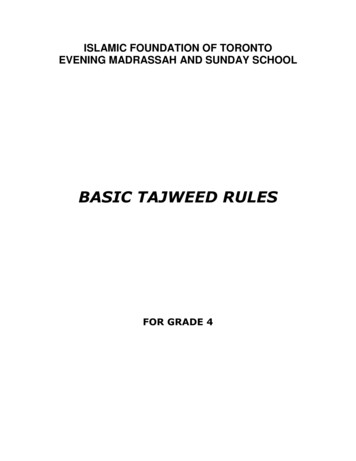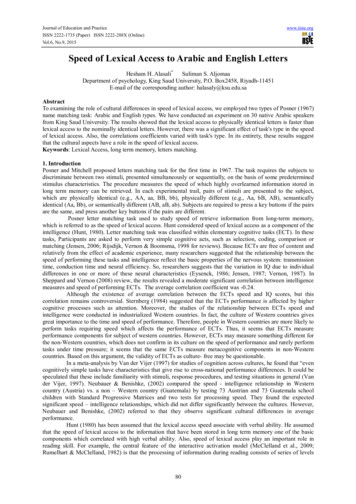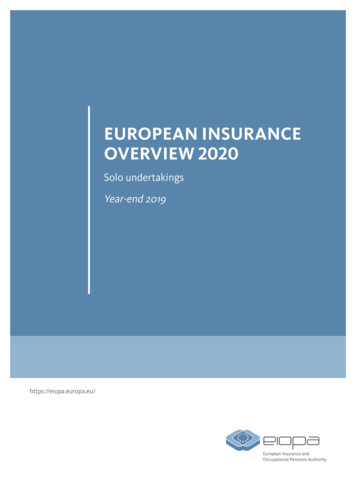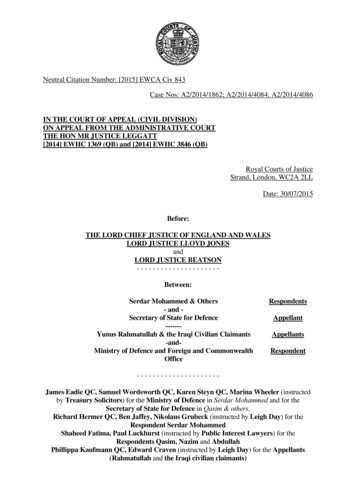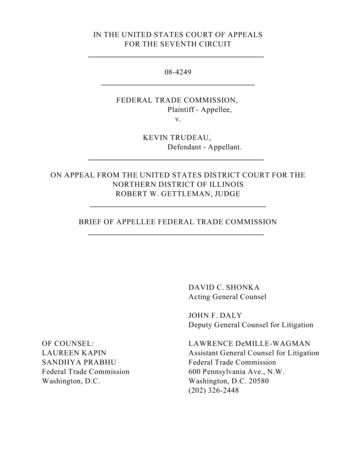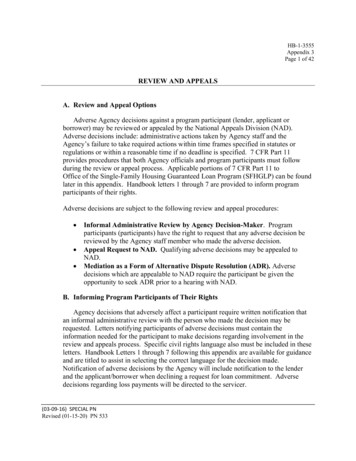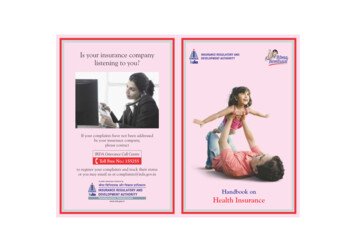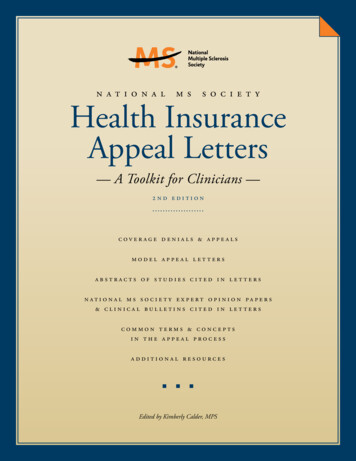
Transcription
nation almssociet yHealth InsuranceAppeal Letters— A Toolkit for Clinicians —2nd editioncoverage denials & appealsmodel appeal lettersabstracts of studies cited in lettersn at i o n a l m s s o c i e t y e x pe rt o pi n i o n pa pe r s& clinical bulletins cited in letterscommon terms & conceptsin the appeal processadditional resourcesnnnEdited by Kimberly Calder, MPS
The National MS SocietyThe National MS Society funds a wide range of research initiatives,drives change through advocacy, facilitates professional education,collaborates with MS organizations around the world, and helpsaddress the challenges of everyone affected by MS.The National MS Society is the largest nonprofit organization in theUnited States supporting research for the treatment, prevention andcure of multiple sclerosis. Through its 50-state network of chapters andthe combined efforts of volunteers, donors, researchers and health careprofessionals, the Society provides significant outreach, education andsupport to individuals and families who are impacted by the disease.
a toolkit for clinicians, 2nd editionHealth Insurance Appeal LettersThis guide is designed to aid in the dialogue between MS clinicians andhealth insurance plans when disputes over coverage arise. This bookis accompanied by a CD that contains easy-to-edit and user-friendlymodel appeal letters.DedicationThis publication is dedicated to the memory of Stephen Cooper,Esq. who served the National Multiple Sclerosis Society from 1997to 2003, and initiated the Society’s professional focus on the healthinsurance needs of people living with MS. It is an honor to continuehis work through the promotion of accessible, affordable and adequatehealth coverage to every person touched by this disease.
Table of ContentsIntroduction: What is this Toolkit for?. . . . . . . . . . . . . . . . . . . . . . . . . . . . . . . . . . . . . . . . . . . . . . . . . . . . . . . . . . . . . . . . . . . . 1Notes on the Second Edition. . . . . . . . . . . . . . . . . . . . . . . . . . . . . . . . . . . . . . . . . . . . . . . . . . . . . . . . . . . . . . . . . . . . 3An Overview: Coverage Denials & Appeals. . . . . . . . . . . . . . . . . . . . . . . . . . . . . . . . . . . . . . . . . . . . . . . . . . . . . . . . . . . . . . . 4Exceptions & Appeals: Medicare Prescription Drug Plans. . . . . . . . . . . . . . . . . . . . . . . . . . . . . . . . . . . . . . . . . . . . . . 7Model Appeal Letters: Templates for Common Multiple Sclerosis Therapies. . . . . . . . . . . . . . . . . . . . . . . . . 8Avonex. . . . . . . . . . . . . . . . . . . . . . . . . . . . . . . . . . . . . . . . . . . . . . . . . . . . . . . . . . . . . . . . . . . . 9Avonex Following First Demyelinating Event. . . . . . . . . . . . . . . . . . . . . . . . . . . . . . . . . . . . . . . . . . . . . . . . . . . . . . . . . . 11Betaseron . . . . . . . . . . . . . . . . . . . . . . . . . . . . . . . . . . . . . . . . . . . . . . . . . . . . . . . . . . . . . . . . . . 12Betaseron After First Demyelinating Event. . . . . . . . . . . . . . . . . . . . . . . . . . . . . . . . . . . . . . . . . . . . . . . . . . . . . . . . . . . . . 13Cooling Vests. . . . . . . . . . . . . . . . . . . . . . . . . . . . . . . . . . . . . . . . . . . . . . . . . . . . . . . . . . . . . . . . . . 14Copaxone. . . . . . . . . . . . . . . . . . . . . . . . . . . . . . . . . . . . . . . . . . . . . . . . . . . . . . . . . . . . . . . . . . . 15Copaxone After First Demyelinating Event. . . . . . . . . . . . . . . . . . . . . . . . . . . . . . . . . . . . . . . . . . . . . . . . . . . . . . . . . . . . 17Erectile Dysfunction Drugs for Men with MS. . . . . . . . . . . . . . . . . . . . . . . . . . . . . . . . . . . . . . . . . . . . . . . . . . . . . . . . . 18IntraVenousImmunoGlobulin (IVIG). . . . . . . . . . . . . . . . . . . . . . . . . . . . . . . . . . . . . . . . . . . . . . . . . . . . . . . . . . . . . . . . . . 19Lower Co-insurance or Co-pay. . . . . . . . . . . . . . . . . . . . . . . . . . . . . . . . . . . . . . . . . . . . . . . . . . . . . . . . . . . . . . . . . . . 20Neurontin. . . . . . . . . . . . . . . . . . . . . . . . . . . . . . . . . . . . . . . . . . . . . . . . . . . . . . . . . . . . . . . . . . 21Neuro-Psych Evaluation. . . . . . . . . . . . . . . . . . . . . . . . . . . . . . . . . . . . . . . . . . . . . . . . . . . . . . . . . . . . . . . . . . . 22Novantrone. . . . . . . . . . . . . . . . . . . . . . . . . . . . . . . . . . . . . . . . . . . . . . . . . . . . . . . . . . . . . . . . . . 23Plasmapheresis. . . . . . . . . . . . . . . . . . . . . . . . . . . . . . . . . . . . . . . . . . . . . . . . . . . . . . . . . . . . . . . . . . 25Power Scooter. . . . . . . . . . . . . . . . . . . . . . . . . . . . . . . . . . . . . . . . . . . . . . . . . . . . . . . . . . . . . . . . . . 27Power Wheelchair, Enhancements to Current Power Chair. . . . . . . . . . . . . . . . . . . . . . . . . . . . . . . . . . . . . . . . . . . 29Provigil. . . . . . . . . . . . . . . . . . . . . . . . . . . . . . . . . . . . . . . . . . . . . . . . . . . . . . . . . . . . . . . . . . . 31Rebif. . . . . . . . . . . . . . . . . . . . . . . . . . . . . . . . . . . . . . . . . . . . . . . . . . . . . . . . . . . . . . . . . . . 32Rebif After First Demyelinating Event. . . . . . . . . . . . . . . . . . . . . . . . . . . . . . . . . . . . . . . . . . . . . . . . . . . . . . . . . . . . . . . . . 33Rehabilitation (PT). . . . . . . . . . . . . . . . . . . . . . . . . . . . . . . . . . . . . . . . . . . . . . . . . . . . . . . . . . . . . . . . . . 34Sterile Intermittent Catheterization. . . . . . . . . . . . . . . . . . . . . . . . . . . . . . . . . . . . . . . . . . . . . . . . . . . . . . . . . . . . . . . . . . 35Tysabri. . . . . . . . . . . . . . . . . . . . . . . . . . . . . . . . . . . . . . . . . . . . . . . . . . . . . . . . . . . . . . . . . . 36
Abstracts of Studies Cited in LettersAvonex (Interferon Beta-1a). . . . . . . . . . . . . . . . . . . . . . . . . . . . . . . . . . . . . . . . . . . . . . . . . . . . . . . . . . . . . . . . . . . .Avonex Therapy After First Demyelinating Event. . . . . . . . . . . . . . . . . . . . . . . . . . . . . . . . . . . . . . . . . . . . . . . . . . . . . .Avonex Following First Demyelinating Event. . . . . . . . . . . . . . . . . . . . . . . . . . . . . . . . . . . . . . . . . . . . . . . . . . . . . . . . . .Betaseron (Interferon Beta-1b). . . . . . . . . . . . . . . . . . . . . . . . . . . . . . . . . . . . . . . . . . . . . . . . . . . . . . . . . . . . . . . . . . . . .Betaseron After First Demyelinating Event. . . . . . . . . . . . . . . . . . . . . . . . . . . . . . . . . . . . . . . . . . . . . . . . . . . . . . . . . . . . .Cooling Vest. . . . . . . . . . . . . . . . . . . . . . . . . . . . . . . . . . . . . . . . . . . . . . . . . . . . . . . . . . . . . . . . . . . .Copaxone (glatiramer acetate). . . . . . . . . . . . . . . . . . . . . . . . . . . . . . . . . . . . . . . . . . . . . . . . . . . . . . . . . . . . . . . . . . . .Erectile Dysfunction Drugs. . . . . . . . . . . . . . . . . . . . . . . . . . . . . . . . . . . . . . . . . . . . . . . . . . . . . . . . . . . . . . . . . . . . .IntraVenousImmunoGlobulin (IVIG). . . . . . . . . . . . . . . . . . . . . . . . . . . . . . . . . . . . . . . . . . . . . . . . . . . . . . . . . . . . . . . . . .Neurontin (gabapentin). . . . . . . . . . . . . . . . . . . . . . . . . . . . . . . . . . . . . . . . . . . . . . . . . . . . . . . . . . . . . . . . . . . .Novantrone (mitoxantrone). . . . . . . . . . . . . . . . . . . . . . . . . . . . . . . . . . . . . . . . . . . . . . . . . . . . . . . . . . . . . . . . . . . .Plasmapheresis. . . . . . . . . . . . . . . . . . . . . . . . . . . . . . . . . . . . . . . . . . . . . . . . . . . . . . . . . . . . . . . . . . . .Provigil (modafinil). . . . . . . . . . . . . . . . . . . . . . . . . . . . . . . . . . . . . . . . . . . . . . . . . . . . . . . . . . . . . . . . . . . .Rebif (Interferon B-1a). . . . . . . . . . . . . . . . . . . . . . . . . . . . . . . . . . . . . . . . . . . . . . . . . . . . . . . . . . . . . . . . . . . . .Rebif After First Demyelinating Event. . . . . . . . . . . . . . . . . . . . . . . . . . . . . . . . . . . . . . . . . . . . . . . . . . . . . . . . . . . . . . . . .Rehabilitation (PT). . . . . . . . . . . . . . . . . . . . . . . . . . . . . . . . . . . . . . . . . . . . . . . . . . . . . . . . . . . . . . . . . . . .Tysabri (natilazumab). . . . . . . . . . . . . . . . . . . . . . . . . . . . . . . . . . . . . . . . . . . . . . . . . . . . . . . . . . . . . . . . . . . .3840414345475052545759616465676972National MS Society: Expert Opinion Papers & Clinical Bulletins Cited in Template Letters. . . . 74“Disease Management Consensus Statement”. . . . . . . . . . . . . . . . . . . . . . . . . . . . . . . . . . . . . . . . . . . . . . . . . . . . . . . . . . 75Changing Therapy in Relapsing Multiple Sclerosis: Considerations & Recommendations. . . . . . . . . . . . 81Assessment & Management of Cognitive Impairment in Multiple Sclerosis. . . . . . . . . . . . . . . . . . . . . . . . . . 87Management of MS-Related Fatigue. . . . . . . . . . . . . . . . . . . . . . . . . . . . . . . . . . . . . . . . . . . . . . . . . . . . . . . . . . . . . . . . . . 100Rehabilitation: Recommendations for Persons with Multiple Sclerosis. . . . . . . . . . . . . . . . . . . . . . . . . . . . . . . 103Patient Access to Tysabri. . . . . . . . . . . . . . . . . . . . . . . . . . . . . . . . . . . . . . . . . . . . . . . . . . . . . . . . . . . . . . . . . . . . 111Bladder Dysfunction in Multiple Sclerosis. . . . . . . . . . . . . . . . . . . . . . . . . . . . . . . . . . . . . . . . . . . . . . . . . . . . . . . . . . . . 114Cognitive Loss in Multiple Sclerosis. . . . . . . . . . . . . . . . . . . . . . . . . . . . . . . . . . . . . . . . . . . . . . . . . . . . . . . . . . . . . . . . . . . 120Pain in Multiple Sclerosis. . . . . . . . . . . . . . . . . . . . . . . . . . . . . . . . . . . . . . . . . . . . . . . . . . . . . . . . . . . . . . . . . . . 123Assessment & Treatment of Sexual Dysfunction in Multiple Sclerosis. . . . . . . . . . . . . . . . . . . . . . . . . . . . . . . . 133Spasticity. . . . . . . . . . . . . . . . . . . . . . . . . . . . . . . . . . . . . . . . . . . . . . . . . . . . . . . . . . . . . . . . . . . 143Common Terms & Concepts in the Appeal Process. . . . . . . . . . . . . . . . . . . . . . . . . . . . . . . . . . . . . . . . . . . . . . . . . . . 151Additional Resources. . . . . . . . . . . . . . . . . . . . . . . . . . . . . . . . . . . . . . . . . . . . . . . . . . . . . . . . . . . . . . . . . . . 154
introductionWhat is this Toolkit for?Due to the increasing pressures of health care cost containment, health plans (both public and private)are demanding greater clinical justification for professional services, drugs, rehabilitation therapies andmore. Common strategies for containing costs within both private plans (employment-based andindividually purchased) AND public plans (Medicare and Medicaid) now include:nprior-authorization (a.k.a. pre-approval) requirementsnutilization reviewndrug formulariesndenials of coverage for off-label use of FDA-approved drugsn“fail first policies” (a.k.a. “step therapy”)ntiered drug benefitsIt is important to acknowledge that cost containment is valuable to all users of the health care systemwhen such measures promote quality and accountability, but may also delay or deny optimal care.The National Multiple Sclerosis Society has developed this guide, as a resource for clinicians who treatpeople with MS and administrative staff in clinical practice settings. The purpose of this guide is to aidin the dialogue between MS clinicians and health plans when disputes over coverage arise. Comparableinformation about appeal rights, responsibilities and procedures should always be described in writingin the Members’ Handbook or Plan Manual.The appeal process of virtually all health plans, including Medicare and Medicaid, is based on theprocedures initially developed by the health insurance industry. Nearly two-thirds of all insured peoplewith MS who are insured are covered by private health plans, and an increasing number of others arecovered by private plans that contract with Medicare or Medicaid.Clinicians and their office colleagues are encouraged to review the following overview and make best useof the template letters as they see fit. Each letter is written as a model only, and includes citations frompublished studies whenever possible. Note that the more tailored the letter is to the medical necessity ofthe prescribed therapy, service or item for that particular patient, the greater the likelihood of gainingcoverage for it. In addition, the model letters reference relevant National MS Society Expert Opinionpapers and we strongly encourage their inclusion in all communications with insurers. This will helppromote knowledge of MS among health plan personnel, as well as visibility of the National MS Societyas a resource for information about medically necessary and appropriate therapies for people with MS.1 n at i o n a l m u lt i p l e s c l e r o s i s s o c i e t y
Finally, it is hoped that users of this guide find ways of making use of these templates, journal citations,and Expert Opinion Papers for communications in other ways. These may include:ntelephone discussion/appeals with health plan Medical or Pharmacy Directorsndialogue with regional Medicare carriers and advisors;nadvocacy for coverage by self-insured employer and union health plans; andnanalysis of hospital (and other institutional) formularies.We strongly encourage your feedback on these model appeal letters and materials. Many thanks to thenumerous individuals who contributed to this effort. Most importantly, the people with MS whom weall serve will benefit greatly from our joint efforts on health coverage concerns, and we thank you ontheir behalf.co n tac tKim Calder, National MS Society733 Third Avenue, New York, NY 10017212 476 0450 kim.calder@nmss.orgh e a lt h i n s u r a n c e a p p e a l l e t t e r s 2
Notes on the Second EditionSince the launch of the first edition of this Toolkit in 2005, many would say that the US health caresystem has become even more complex, costly and burdensome for all concerned. Health care costshave continued to rise with no clear consensus on how to contain them. Health plans have respondedby shifting more of the cost burden to patients, with even greater scrutiny of providers’ clinical decisionmaking. Medicare drug plans, pharmaceutical benefit managers (PBMs), specialty pharmacies, diseasemanagement and other entities have emerged as important stakeholders. Although most people withMS have health coverage, rising out-of-pocket costs, (especially co-payments and/or co-insurance forprescription drugs) jeopardize their adherence to treatment and force painful choices between healthcare and other necessities. Health care professionals specializing in the care of people with MS haveexpressed fear for the future of their practices, patients’ welfare and research endeavors.Despite these challenges, a common element of various efforts aimed at containing costs and improvingthe quality of care, such as electronic medical records, standardization of claims procedures and overalltransparency, is clear, up-to-date and accessible documentation of patients’ status, needs and treatments.The National MS Society has encouraged health care professionals to provide good documentationon their patients’ behalf when requested by payers, employers, government agencies, disability andother insurers (provided confidentially is assured). Efforts such as this toolkit have been praisedby clinicians for highlighting the types of documentation viewed as most effective by health plans, theSocial Security Administration and others.In addition to new appeal letters and corresponding citations on specific MS therapies, this toolkitincludes a new and adaptable model appeal letter requesting a lower co-payment or co-insurancerequirement for a patient. Although this letter has been used by people with MS who experienceda dramatic increase in their out-of-pocket cost for their disease modifying therapy, it can be adaptedto assist patients’ facing unaffordable co-payments for any covered service, treatment or equipment.Although a successful outcome is not guaranteed, filing an appeal of this type for patients withextraordinary needs and costs is a legitimate method of advocating for people with MS.We hope the content and format of this toolkit encourages providers and their practice colleaguesto pursue productive interactions with health plans and others committed to quality MS care.3 n at i o n a l m u lt i p l e s c l e r o s i s s o c i e t y
an overviewCoverage Denials & Appealsthe right of every insured personChallenging a coverage denial by a health insurance plan is a legal right guaranteed to all insuredindividuals. Every plan—including private policies, employer-sponsored health plans, Medicare,Medicare drug plans and Medicaid—must provide a process for re-consideration of any adversedetermination by the plan. Among people with MS who are health plan members, anecdotal reportsshow that delays or denials are most common for drugs, dosages, quantities or routes of administrationexcluded from the formulary; for drugs or devices prescribed off-label; for services that are not covered,have exceeded the coverage limit or were not properly authorized; and supplies or equipment that arenot covered or deemed “not medically necessary”.successful appealsThe success rate of health coverage appeals provides the most compelling argument for pursuingthem—more than 50% of appeals of denials for coverage or reimbursement by health insurers are ultimatelysuccessful in favor of the covered individual. Success may not be achieved at the first level of appeal,and is more likely with consecutive and (politely) persistent appeal challenges. Private and employersponsored health plans typically provide at least two levels of appeal, and Medicare and Medicaidguarantee multiple levels of appeal that are roughly comparable to the first and second level appeals inprivate plans. By law, Medicare prescription drug plans must provide for exceptions and appeals.Appeals are most likely to be successful when presented in accordance with the plan’s appeals processand timeframe. The most effective appeal letters are very clear statements about the purpose of theletter, factual and brief. Most importantly, appeal letters must be tailored to the specific patient’s need(s)as documented in the medical record, and provide a clinical justification in support of the recommendedtreatment, item or service.w h e n i s i t a p p ro p r i at e to f i l e a n a p pe a l ?When a denial of coverage has been made, patients and/or their clinicians should pursue an appeal afterconsidering the following:1 Is the treatment, service or item medically necessary and indicated for this patient, at this point in time?2 Is the treatment, service or item a covered benefit under the patient’s plan? If the desired treatment,service or item is clearly listed as an uncovered benefit, there is virtually no value in pursuing anappeal. However, if the plan materials are unclear or silent on the matter, an appeal is warranted.3 Is the denial based on a clerical error or missing information? If the denial has not already beenprovided in writing, request it immediately and examine it for errors, such as in the member’s IDnumber, diagnostic or service code, or date of service.4 Has the patient’s co-payment or co-insurance amount for a covered service, drug or item recentlyrisen and become un-affordable to the patient? (See page 5)h e a lt h i n s u r a n c e a p p e a l l e t t e r s 4
w h e n t h e p ro b l e m i s u n - a f f o rd a b l e c o s ts to t h e pat i e n tAs health plans shift more of the cost of care on to patients in the form of higher co-payments orco-insurance amounts for covered benefits, adherence to care suffers as patients’ cost burdens becomeunaffordable. It is important for MS patients, caregivers and clinicians to know that appealing to ahealth plan for a lower co-payment or co-insurance amount is appropriate and encouraged whennon-adherence is the alternative. Such appeals are most likely to succeed when the patient or clinician’sletter accurately details exactly how and when a co-payment or co-insurance amount increased due toa formulary, tiering or policy change by the health plan. In such instances, a request for a return to theformer, affordable cost-sharing arrangement (aka “grandfathering in”) is warranted, especially whensupported by details of the likely result on the patient if the exception is not granted. A model appealletter requesting a lower co-payment or co-insurance amount for the patient is included in this toolkit.t h e r o l e o f pat i e n t s , & h e a lt h c a r eprofessionals, in the appeal processIn most health plans, an appeal of a coverage denial may be initiated by the individual patient (or his/her caregiver) OR the prescribing health care professional (HCP), and is best viewed as a collaborationbetween patient and clinician. However, requests for exceptions to Medicare drug plan formularies andrules must be filed by the prescribing physician. Insured patients should understand that the health planis accountable to them as the covered individual and contract holder, not the patient’s health professional.Additionally, patients and providers should be aware that health plans have no legal obligation to acceptappeals received after the timeframe spelled out in the insurance contract.The role of HCPs in the appeal process is an extension of their role as providers of high quality patientcare. Providing documentation from the patient’s medical record and supporting evidence of medical necessityin the form of a letter to the health plan may seem like a time-consuming duplication of effort, but italso provides a check on accountability, safeguard of quality and a means of elevating standards of MSpatient care. If or when health plans delay or deny coverage, the prescribing clinician should demonstratea willingness to back-up his/her clinical recommendation with such a letter including citations fromrelevant published studies, personal experience and available evidence. HCPs should also be aware thatwhen dealing directly with health plan personnel regarding coverage issues, a cooperative and professionalattitude is cited by industry insiders as key to a successful appeal.5 n at i o n a l m u lt i p l e s c l e r o s i s s o c i e t y
the appeal processIn general, the appeal process is similar in all plans, except Medicare prescription drug plans, whichinclude additional rules and some different terminology. (See “Appealing to a Medicare PrescriptionDrug Plan” below.) There are typically two, but often three levels of appeal available to plan membersdepending on the type of plan. Although the medical expertise of the individuals responsible forconducting the appeals generally increases with each successive level, denial of the first level is requiredbefore the second level of appeal may be pursued. Both first and second levels of appeal, (togetherreferred to as internal appeals because they are conducted by the health plan), must be exhausted beforean external review may be requested.If, in the judgment of the prescribing provider, delay in treatment would pose a danger to the patient’shealth, or result in the inability to regain maximum function, an expedited or accelerated review shouldbe requested. (Expedited reviews typically cut the review time to 2 to 3 days at most.)nnnFirst Level Appeal: Also known as an informal review, this level of appeal is the most cursory.Although typically conducted by a Claims Reviewer, federal law (ERISA) requires that a licensedmedical professional sign off on all appeals.Second Level Appeal: Also known as a formal appeal, a small group of reviewers (including onelicensed physician in the same or similar specialty) conducts this level appeal. Some plans allow themember or his/her representative to attend a meeting of the group and present the case and anynew information.External Appeal: Also known as independent or external review, an external appeal is conducted byneutral parties. If availability to an external appeal is a right established by state law (and thereforelimited to plans subject to state law/regulation), the state’s Commissioner of Insurance is responsibleand should be contacted for information regarding process, timeframes and possibly fees for theapplicant. Remember, first and second level appeals must be exhausted first.h e a lt h i n s u r a n c e a p p e a l l e t t e r s 6
exceptions & appealsMedicare Prescription Drug PlansThe following information and procedures for filing an exception or appeal is the same for stand-aloneprescription drug plans (PDPs) and Medicare Advantage (managed care) plans that include drugcoverage (MA PD).Note that by law, Medicare prescription drug plans must cover certain drugs, but are prohibitedfrom covering many others. With a few exceptions, Medicare drug plans are prohibited from coveringtreatments for anorexia, fertility, cosmetic purposes or hair growth, cold relief, erectile dysfunction, aswell as barbiturates, benzodiazepines, vitamins, minerals and other over-the-counter drugs. Additionally,drugs prescribed for off-label uses are likely to be denied unless its use is listed in one of three Medicareapproved drug compendia.request an exception to a medicare prescriptiond ru g p l a n u n d e r t h e f o l low i n g c i rc u m s ta n c e snnnnThe medically necessary drug, preferred route of administration or dose is not on the plan’s formulary;The prescribing physician believes the generic substitution provided in place of a prescribed brandname drug will be ineffective or cause harm;The plan imposes restrictions on the prescribed drug, including a prior authorization request, steptherapy, or limits on the prescribed quantity.The prescribed drug is in a higher (more costly) “tier” than similar drugs on the formulary. Note thatMedicare drug plan members will not be granted an exception for a request that a drug in a “specialtytier” be moved to a lower, less costly tier.1 Your Medicare patient may not be aware that the drug you prescribed falls into one of the categoriesabove until they attempt to fill or re-fill it. Your options will then be to either change the prescription,request an exception, or request an expedited exception in an emergency. Only clinicians licensed toprescribe medications can request an exception.2 If you and your patient choose to request an exception, you (the prescriber) must state in writingthat your originally prescribed drug is medically necessary, and you must include a justification forthe .specific exception request. Be sure to ask for an exception for the rest of the plan year oreven in.definitely if the drug is for a chronic condition. To request an exception to a restriction(quantity limit, prior authorization request or step therapy for the rest of the year), state that thepatient requires an override to the restriction.3 You or your patient can find out where to send the exception request by calling the drug plan,checking their website, or the patient’s member handbook (aka “Evidence of Coverage”). Makea copy for your patient, and keep one on file.4 The plan must respond to your exception request within 72 hours, or 24 hours for an epeditedexception. If the plan does not respond on time, the exception request is considered denied.5 If the plan denies, or does not respond to your exception request on time, you may then file anappeal. Your patient may also wish to file a complaint with the plan if they did not respond on time.See the section “Additional Resources on Health Insurance and Appeals” for additional help.7 n at i o n a l m u lt i p l e s c l e r o s i s s o c i e t y
model appeal lettersTemplates for CommonMultiple Sclerosis TherapiesThis section includes template, or sample, letters of appeal to health plans for submission by theprescribing physician. The selection of specific subjects for these letters was based on input from MSspecialists around the country, as well as the experiences of Society clients and staff. They relate tothose drugs, therapies and items that are thought to be most often denied for coverage by health plans,although others may also be warranted.physicians or others using theset e m p l at e s s h o u l d b e c a r e f u l to :1 Tailor the wording of the letter to the status of the pre-authorization request, claim, coveragedenial or other;2 Include details from the patient’s chart to support the argument (while keeping the letter to onepage if possible); and3 Coordinate efforts directly with the patient before writing the appeal letter to avoid confusion andpossible duplication of effort. Remember that you and your patient only have two or three opportunitiesto win an appeal. It is easy to “waste” one of these opportunities through not coordinating all appealefforts with your
This guide is designed to aid in the dialogue between MS clinicians and health insurance plans when disputes over coverage arise. This book is accompanied by a CD that contains easy-to-edit and user-friendly . The National Multiple Sclerosis Society has developed this guide, as a resource for clinicians who treat
